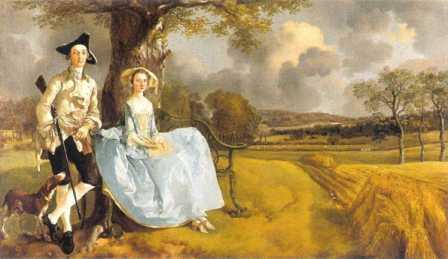The second of this month’s four pictures for summer is Thomas Gainsborough’s much loved portrait of the English country squire Robert Andrews and his young wife, enjoying the August sunshine on their country estate. The work was painted in about 1750. Now widely regarded as one of the quintessential masterpieces of English painting, Mr and Mrs Andrews was virtually unknown until 1927, when it was put on public display for the first time, in Gainsborough’s bicentenary exhibition at
The picture was commissioned to celebrate the marriage of Robert Andrews and his bride, Frances Mary, nee Carter, which took place in the parish church of All Saints, Sudbury, on 10 November 1748. Close inspection of the landscape reveals that the painter has artfully created a break between the trees in the woodland behind Mrs Andrews, through which the church where the couple made their vows can be seen. The picture is a gentle celebration of good husbandry, in every sense. Mr Andrews, gundog by his side, gun held under his arm, is presented as the very embodiment of self-assured, nonchalant dependability. His credentials, it can be safely assumed, are as solid as the oak that shelters him and his wife. She will want for nothing. The extensive landscape which the couple occupy is the guarantee of their future prosperity. Gainsborough presents it as a fertile, secular paradise, a green and gold English Eden. Sheaves of recently cropped corn are piled in an abundant stack in the foreground. Wild flowers grow in the margins of the field and partridge can be seen nesting...


